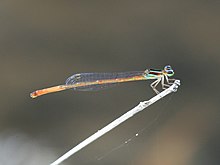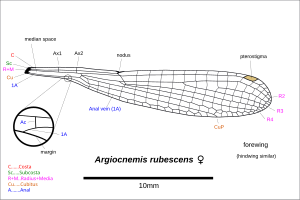
The red-veined darter or nomad is a dragonfly of the genus Sympetrum.

Agriocnemis is a genus of damselfly in the family Coenagrionidae. Agriocnemis is distributed widely across Africa, South-east Asia, Indonesia, Australia and islands in the Pacific. They are small insects, commonly known as wisps.

Argiocnemis is a genus of damselfly in the family Coenagrionidae. Species of Argiocnemis are generally small to medium-sized damselflies, darkly coloured with pale markings. They occur in Africa, Indian Ocean islands, South-east Asia, New Guinea and Australia.

The red and blue damsel is a damselfly in the family Coenagrionidae. It is the only member of the monotypic genus Xanthagrion.

The common flatwing is a very common species of damselfly of the subfamily Argiolestinae in the family Megapodagrionidae. It is also known as an Australian flatwing.

The blue riverdamsel, Pseudagrion microcephalum is a common species of damselfly in the family Coenagrionidae. It is also known as the blue sprite and blue grass dart.

The orange threadtail or ochre threadtail is an Australian damselfly in the family Platycnemididae. They are medium-sized with a length of around 35mm. Orange threadtails can be found near semi-shaded running water, and usually rest on plants at the water's edge. Orange threadtails may be seen all year round. In Victoria they occur at lower altitudes during summer, though further north they can be seen in spring and autumn. When at rest, Nososticta damselflies hold their wings closely folded up vertically over their thorax. The male threadtails have an orange-yellow thorax with black patterns. Their abdomen is narrow, black in colour with yellow strips. There is a brown yellow colour at the base of their wings. Females are the same size as the males. They are pale brown in colour and have the same black patterns as the males.

Austroagrion cyane, the south-western billabongfly, is a species of damselfly of the family Coenagrionidae. Despite their common name, they have been found not only in south-western Australia, but also in diverse locations across Australia.
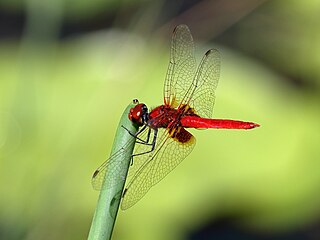
Aethriamanta circumsignata known as the square-spot basker is a species of dragonfly in the family Libellulidae. It is found in Australia, and New Guinea. The species is usually found near still or sluggish waters.

Indolestes tenuissimus is a species of damselfly in the family Lestidae, commonly known as the slender reedling. It is found in north-eastern Australia, New Guinea and on Aru.
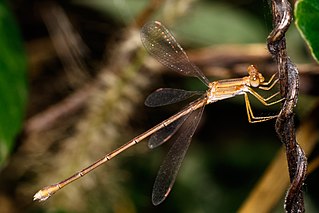
Lestes concinnus is a species of damselfly in the family Lestidae, the spreadwings. They are so named because they rest with their wings spread. This species is known commonly as the dusky spreadwing. It is a nomadic damselfly found in India, Southeast Asia as far as New Caledonia, and northern parts of Australia.
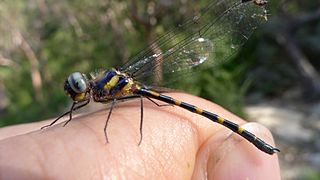
Cordulephya pygmaea is a species of dragonfly of the family Cordulephyidae, also known as the common shutwing. It inhabits streams in eastern Australia. It is small to tiny in size, coloured black, or purplish-black, with yellowish markings. It rests with its wings folded above its body in a similar manner to a damselfly.
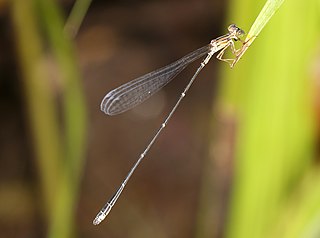
Oristicta filicicola is a species of damselfly belonging to the family Isostictidae. Until 2017 it was the only species of the genus Oristicta. Commonly known as a slender wiretail, it is a slender and dull-coloured damselfly of medium-size. It is endemic to north-eastern Australia, where it inhabits streams in rainforests.

Teinobasis rufithorax is a species of damselfly in the family Coenagrionidae, commonly known as a red-breasted longtail. It is found on Cape York Peninsula, in Queensland, Australia, and on Torres Strait islands, Maluku Island, Aru Islands, New Guinea, Bismarck Archipelago and the Solomon Islands. It inhabits shaded, deep waters.
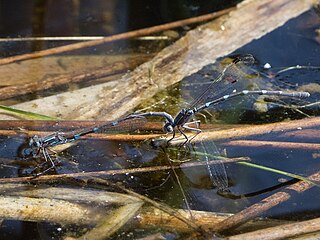
Austrolestes io is an Australian species of damselfly in the family Lestidae, commonly known as an iota ringtail. It has been found in both south-western Australia as well as south-eastern Australia where it inhabits pools, lakes and ponds.
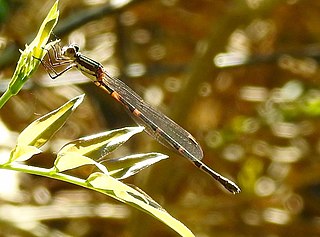
Austrolestes leda is an Australian species of damselfly in the family Lestidae, commonly known as a wandering ringtail. It is found across eastern Australia where it inhabits slow and still water.
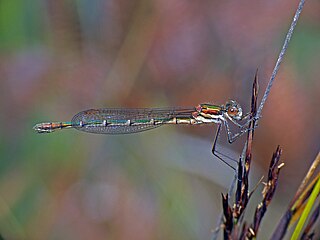
Austrolestes psyche is an Australian species of damselfly in the family Lestidae, commonly known as a cup ringtail. It is found in south-eastern Australia where it inhabits pools, lakes and swamps.

Diphlebia lestoides is a species of Australian damselfly in the family Lestoideidae, commonly known as a whitewater rockmaster. It is endemic to south-eastern Australia, where it inhabits streams and rivers.

Griseargiolestes griseus is a species of Australian damselfly in the family Megapodagrionidae, commonly known as a grey flatwing. It is endemic to south-eastern New South Wales, where it inhabits bogs and seepages near small streams.

Synlestes weyersii is a species of Australian damselfly in the family Synlestidae, commonly known as a bronze needle. It is endemic to south-eastern Australia, where it inhabits streams and rivers.

